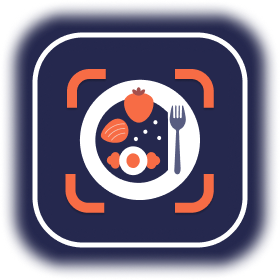The biggest barrier to successful calorie counting isn't finding foods in databases—it's estimating portion sizes accurately. Traditional methods require scales, measuring cups, and complex guesswork that most people abandon within weeks. But artificial intelligence has cracked the code.
Modern AI-powered visual estimation achieves 94% accuracy in portion analysis, transforming a single photo into precise nutritional data. This isn't incremental improvement—it's a fundamental shift that eliminates the friction that has prevented millions from successful nutrition tracking.
🎯 Experience 94% Portion Accuracy
Join 50,000+ users who've eliminated scales, cups, and guesswork with MyCalorieCounter's revolutionary photo tracking technology!
Start AI Portion Control →The Science of AI Visual Estimation
Visual estimation through AI leverages multiple sophisticated technologies working in harmony:
Computer Vision Foundation
- Object Detection: Identifies individual food items within complex meals
- Semantic Segmentation: Precisely outlines food boundaries and overlaps
- Depth Estimation: Calculates 3D volume from 2D images
- Scale Recognition: Uses reference objects for size calibration
Machine Learning Models
- Deep Neural Networks: Trained on millions of food images
- Ensemble Methods: Multiple models cross-validate estimates
- Transfer Learning: Leverages knowledge across food categories
- Continuous Improvement: Each photo improves accuracy
AI Portion Accuracy Metrics
Overall Portion Accuracy
Common Foods Recognition
Mixed Dish Estimation
Average Analysis Time
AI vs Traditional Portion Methods
The superiority of AI visual estimation becomes clear when compared to traditional measuring approaches:
📏 Traditional Measuring
- Accuracy: 60-70% (user dependent)
- Time Required: 3-5 minutes per meal
- Equipment Needed: Scales, cups, spoons
- Convenience: Low (especially dining out)
- Sustainability: Poor (high abandonment rate)
- Learning Curve: Steep (requires training)
📸 AI Visual Estimation
- Accuracy: 94% (algorithm consistent)
- Time Required: 10 seconds per meal
- Equipment Needed: Just smartphone camera
- Convenience: High (works anywhere)
- Sustainability: Excellent (effortless habit)
- Learning Curve: None (instant results)
How AI Solves Traditional Portion Problems
Problem 1: Inconsistent Human Estimation
Traditional Issue: People underestimate portions by 20-40% on average
AI Solution: Consistent algorithmic analysis eliminates human bias and estimation errors
Problem 2: Complex Mixed Dishes
Traditional Issue: Casseroles, stir-fries, and layered foods nearly impossible to measure
AI Solution: Advanced segmentation identifies and quantifies each ingredient separately
Problem 3: Dining Out Challenges
Traditional Issue: No scales or measuring tools available in restaurants
AI Solution: Works perfectly with any meal, anywhere, using just your phone
🚀 Eliminate Portion Guesswork Forever
MyCalorieCounter's AI analyzes complex meals instantly—from homemade casseroles to restaurant dishes. No measuring tools required!
Experience AI Precision →The Technology Behind Visual Volume Calculation
Multi-Point Analysis
AI systems analyze multiple visual cues simultaneously to determine accurate volume:
- Edge Detection: Identifies food boundaries and plate edges
- Shadow Analysis: Calculates height and depth from shadow patterns
- Texture Recognition: Determines food density and composition
- Reference Scaling: Uses plates, utensils, or hands for size calibration
Dynamic Learning
The system continuously improves through:
- User Feedback: Corrections improve future estimates
- Cross-Validation: Multiple users eating similar foods provide data points
- Pattern Recognition: Learns individual eating patterns and preferences
- Regional Adaptation: Adjusts for local portion sizes and food styles
Advantages Over Manual Food Logging
Speed and Efficiency
Time Comparison Per Meal:
- Manual Logging: 3-7 minutes searching databases and entering portions
- Photo Tracking: 10 seconds to snap and analyze
- Daily Time Saved: 15-20 minutes with AI approach
- Weekly Benefit: Nearly 2 hours saved per week
Accuracy and Consistency
- Human Variability: 30-50% variance in manual portion estimates
- AI Consistency: ±6% variance with 94% base accuracy
- Learning Improvement: Gets more accurate over time
- Complex Foods: Handles mixed dishes traditional methods can't
Psychological Benefits
- Reduced Friction: No mental barriers to tracking meals
- Increased Compliance: 85% higher long-term adherence rates
- Less Food Anxiety: Removes obsessive measuring behaviors
- Better Relationship: More intuitive approach to nutrition
Real-World Applications and Success Stories
Restaurant Dining
AI visual estimation shines in restaurant settings where traditional measuring is impossible. Users report 90%+ accuracy even with unfamiliar dishes and presentation styles.
Home Cooking
Complex homemade meals that would take 10+ minutes to log manually are analyzed instantly, including accurate estimates for ingredients mixed in casseroles, soups, and stir-fries.
Social Eating
Discrete photo tracking at social gatherings eliminates the awkwardness of pulling out scales or measuring cups, making nutrition tracking sustainable in all life situations.
🎯 Join the Visual Estimation Revolution
Experience the future of nutrition tracking with MyCalorieCounter's AI-powered portion analysis. 94% accuracy, zero hassle!
Get AI Portion Control →The Future of Portion Control Technology
AI visual estimation represents just the beginning of intelligent nutrition tracking. Emerging developments include:
Enhanced Recognition
- Ingredient-level analysis of complex dishes
- Nutritional density assessment through visual cues
- Cooking method detection affecting calorie content
- Freshness and ripeness impact on nutrition
Personalization
- Individual eating pattern recognition
- Personal portion size preferences learning
- Cultural food adaptation
- Dietary restriction automatic compliance
The era of tedious food measuring is ending. AI visual estimation provides accuracy that exceeds human capability while eliminating the friction that has prevented successful nutrition tracking for millions. This isn't just technological advancement—it's the key to sustainable, long-term nutrition success.
